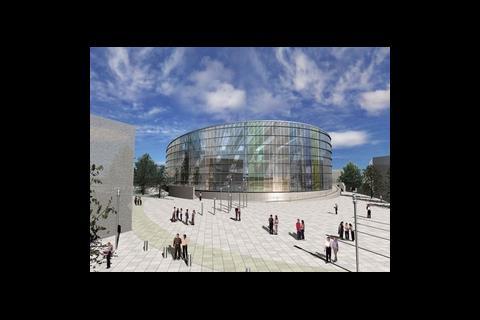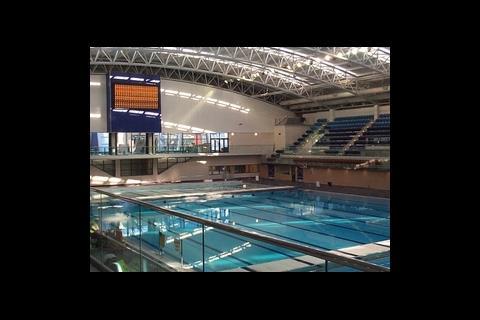Sustainable approaches can make or break your bid to design new leisure facilities. Barry Redman, the head of Silcock Dawson’s energy and sustainable design group, discusses what will and won’t wash
The cornerstones of sustainable design for leisure facilities are not so different from those for the commercial and residential sectors minimising energy use and welcoming in as much natural light as possible are key. But there are specific considerations when dealing with, say, a large indoor swimming pool design.
Positioning, orientation and form
Minimising energy consumption is the initial challenge for the design team and early discussions about the positioning, orientation and form of the building are vital to providing a truly sustainable development.
This will enable the opportunities for passive solar heating to be realised without adverse effect on the cooling loads during summer peaks. Swimming pools operate with air temperatures of 29-32ºC year round. With heating and ventilation thus a significant source of energy use, a high-performance fabric coupled with passive design can result in considerable cuts in the amount of energy consumed.
The lighting strategy should also be considered at this stage. The incorporationof daylighting into the development contributes to reducing what is another significant burden.
Energy usage
The next goal is to identify the likely end uses of energy and formulate strategies to reduce them. The most obvious measure is the use of heat recovery in the ventilation system, although there are other opportunities.
A variable air volume system is the preferred option, with a target specific fan power of 1.5W/l/s. A low-velocity system will reduce fan power consumption although it will require larger duct sizes, so consultation with other members of the design team is essential to ensure space is available for them.
Heat recovery can also be incorporated into the back-washing of the pool filter and the showers’ waste system. These sources of heat may be low grade but they can be used to preheat the hot-water feed.
Depending on the type of leisure centre, it may be possible for heat rejected from cooling systems to be recovered and used for pool heating or pre-heating of domestic water.
In one mixed-use development incorporating a leisure centre with an ice rink and swimming pool, it was possible to achieve carbon dioxide emission reductions of 5-8% by using heat recovered from the ice-making and air-conditioning plant.
Another option is the use of pool covers during unoccupied periods, which can offer significant energy savings of 10-15%. The payback period is as low as 18 months.
Lighting systems are the third significant end use for energy. As well as maximising daylighting, this can be achieved with the specification of high-efficiency luminaires with an appropriate lighting control system.
Energy supply
The next aim is to supply the energy required efficiently. The use of high-efficiency equipment and the zoning of systems for usage and patterns is standard practice. There are numerous strategies that can be employed but they need to be matched to an appropriate end use so they operate at maximum efficiency.
CHP is well suited to leisure facilities because of the high constant base load heating requirement, and can reduce carbon dioxide emissions by 15-20%.
Biofuel CHP would offer excellent savings but this emerging technology is not generally considered viable in leisure facilities because of uncertainty over the reliability of the equipment and fuel supply.
The environmental impact of biofuel production and distribution also needs careful study. Natural-gas-fired CHP is the preferred option although the size of the units needs to be considered along with any renewable system being specified.
CHP opens up other options that need to be considered during the design. The first is the application of an absorption chiller to produce a combined cooling, heat and power (CCHP) unit. This, however, is not the most effective method for energy and carbon reduction in leisure centres. Conventional chillers with heat recovery can provide greater benefits.
When compared with conventional chillers, a CCHP system will yield carbon savings of 0.082kgCO2/kWhr of coolth generated. But, in comparison with conventional chillers with heat recovery, the carbon saved by heat recovery – assuming all heat rejected can be usefully used – would be 0.0259kgCO2/kWhr of delivered cooling, based on an absorption chiller efficiency of 80% and a conventional chiller with a coefficient of performance (COP) of 3.
A second consideration is the need to maximise the run time of the unit, which can be achieved through supplying local residential areas. In the broader sense of sustainability, developing leisure centres with housing, or in proximity to existing housing, provides a number of benefits.
The possibility of district heating and electricity schemes can be explored but there is also the impact on the local community of having a leisure centre “on the doorstep”, which can provide a focus point, reduce car travel and promote a healthy lifestyle. The CHP system at the Pool in the Park in Woking, Surrey, uses the swimming pool as the base load to make a wider scheme viable.
With CHP already well suited to leisure centres and draft alterations to the London Plan stating that CHP should be considered before renewables, the type and integration of any renewable system with CHP needs to be considered carefully to maximise energy and carbon savings.
Silcock Dawson & Partners is in discussions with the Greater London Authority about the coupling of CHP with a number of renewable technologies for a leisure centre development. The systems under consideration are CHP in conjunction with biomass boilers or ground source heat pumps (GSHP).
Whatever route is chosen, the key is to size and match the systems correctly to their end use. The preferred options for the envisioned scheme are using CHP to meet the hot water and pool heating demands and the GSHP to supply space heating demands via underfloor coils, where the lower temperatures optimise COP.
GSHP can also be used for cooling in summer when there is no space heating demand. Other measures that are being incorporated into the central plant include a thermal buffer store to increase CHP efficiency.
Where renewable technologies have been specified, monitoring of their performance over time should be conducted as a matter of course, so that predictions for the operation of future systems can be refined.
Water consumption and drainage
Back-washing of swimming pool filters can use large amounts of water. A new type of regenerative filter reduces the frequency of back-washing from once a week to once a month for typical applications.
The use of rainwater harvesting and grey-water recycling can significantly reduce water consumption. One application is the use of water from the showers and pool filter back-washing to flush the toilets.
Source
�ǿմ�ý Sustainable Design



















No comments yet